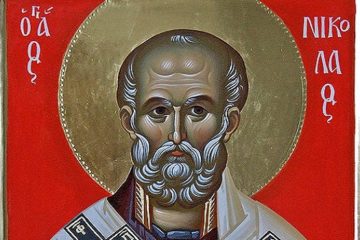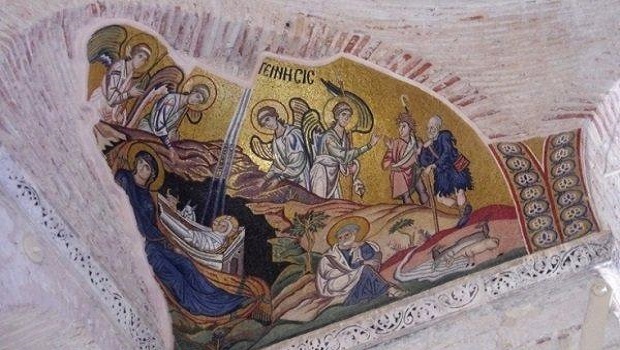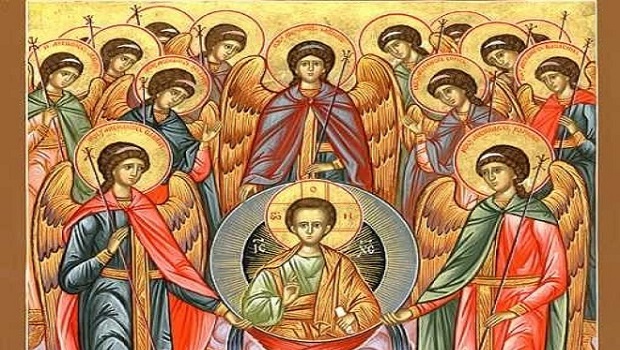Elder Efraim, Abbot of the Holy and Great Monastery of Vatopaidi, the Holy Mountain
Every time we celebrate the Dormition of the Mother of God it’s as though we have Easter again. The summer Easter. Our Lady the Mother of God prepares Easter for us. A glorious crossing ‘from death to life’. A second Easter, holy, spotless, giving life to the human race, because today, in truth ‘ the laws of nature are overcome’.
Saint John the Damascan declares: ‘How the source of life goes to life, passing through death’. The death of the ‘life-giving Mother’ of the Lord surpasses the notion of death, so that it’s not even called death, but rather ‘dormition’, and ‘divine transition’ and a departure towards or arrival in the Lord. And even if it’s called death, it’s still a death which brings life, since she makes the transition to celestial and eternal life.
This transition of the Mother of God, as an undeniable fact, preserved by holy Tradition, has been incorporated into the teaching of the Orthodox Church and has no relation to the pious doctrines of the West concerning immaculate conception and the Mother of God’s life without death.
The Virgin was the special creation of God, who surpassed all people and all angels. Of all humankind, she alone led a spotless life and- beyond the understanding of all rational beings- became the Mother of God. Since she never sinned, she rightly never submitted to any thoughts of pleasure, nor did she live on earth with the pleasures of the flesh or with illness. Even though she had the body which gave life to the Lord, still, as a human person, she was subject to the sickness of death and did, indeed, die. But her soul was not separated from God and neither was her body. For a short time, the bond linking them together was loosed, as had been the case with Christ. After death, her soul was immediately united with Christ. Because, at the hour of His Mother’s dormition, the Lord, accompanied by the celestial hosts and the saints, took her holy soul not simply to heaven but ‘to His royal throne, to the celestial Holy of Holies’, as Saint John the Damascan tells us. And then, after three days, the life-giving and God-receiving body of Our Lady was translated, without decay, to realms above the heavens, to her Only-Begotten and beloved Son. It’s therefore appropriate to talk of the resurrection of the Mother of God in the body, though this resurrection was not initiated by Our Lady herself, but by her Son and God.
One witness of this resurrection, this transition of the Mother of God, was the Apostle Thomas, who wasn’t present at her holy burial, but, as usual, arrived late, in this case by three days. At his request, the other Apostles opened the grave but didn’t find the body which had been glorified by God. They did, however, see the Mother of God ascending into heaven, and she gave the Apostle Thomas her belt as proof of her translation. This was rather similar to what had happened when the same man had needed to touch Christ after the Resurrection.
As was the case with her Son, the body of the Mother of God did not suffer any disintegration in the grave. In other words, it wasn’t changed and the material elements which constituted it didn’t dissolve. In any case, since Christ’s Resurrection, the bodies of many of the saints have not decayed and have become partially uncorrupt relics. So it’s more than reasonable, then, that the ‘life-receiving dwelling’ which was the Mother of God would not decompose.
Saint Andrew of Crete says that the preservation of the virginity of the Mother of God during the birth of Christ had as its natural concomitant the incorruption of her body at the hour of her death. ‘Birth avoided any abrasion and the grave would not accept decomposition’.
After her dormition, Our Lady became the Mother of the new creation, of the Church of Christ. Since she had the central position in God’s dispensation for our salvation (because the Lord, Who is the head of the Church, became incarnate through her), she now has, in the celestial Church, all the fulness of Grace, glory and boldness. She’s become the benefactress of nature and creation, which is why she’s venerated by the whole of creation as Lady, Maiden, Queen and Mother of God.
Through the Mother of God, and because of her, the history of the whole world entered upon a new path, incomparably more magnificent and superior to that which had existed before her. Nothing could or ever can become more perfect than she, nor could she herself become more perfect than she is. According to the Fathers, there are three things that our all-powerful God couldn’t improve on: the incarnation of His Word; the Virgin Mother of God; and the bliss that is to be enjoyed by those who are saved.
(to be continued)
Source: pemptousia.com




0 Comments